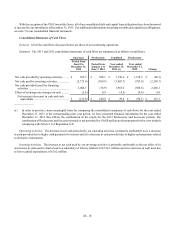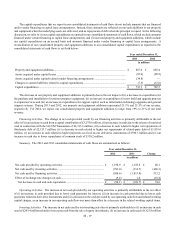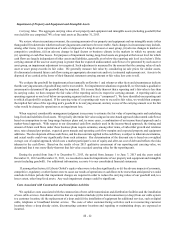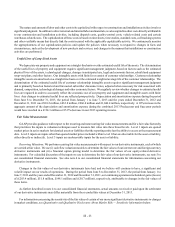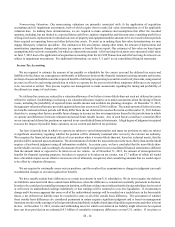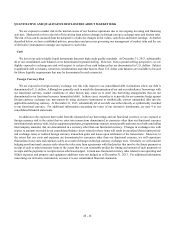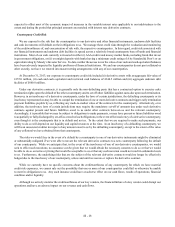Virgin Media 2013 Annual Report Download - page 138
Download and view the complete annual report
Please find page 138 of the 2013 Virgin Media annual report below. You can navigate through the pages in the report by either clicking on the pages listed below, or by using the keyword search tool below to find specific information within the annual report.III - 28
expected to offset most of the economic impact of increases in the variable interest rates applicable to our indebtedness to the
extent and during the period that principal amounts are matched with interest rate derivative contracts.
Counterparty Credit Risk
We are exposed to the risk that the counterparties to our derivative and other financial instruments, undrawn debt facilities
and cash investments will default on their obligations to us. We manage these credit risks through the evaluation and monitoring
of the creditworthiness of, and concentration of risk with, the respective counterparties. In this regard, credit risk associated with
our financial instruments and undrawn debt facilities is spread across a relatively broad counterparty base of banks and financial
institutions. Most of our cash currently is invested in either (i) AAA credit rated money market funds, including funds that invest
in government obligations, or (ii) overnight deposits with banks having a minimum credit rating of A by Standard & Poor’s or an
equivalent rating by Moody’s Investor Service. To date, neither the access to nor the value of our cash and cash equivalent balances
have been adversely impacted by liquidity problems of financial institutions. We and our counterparties do not post collateral or
other security, nor have we entered into master netting arrangements with any of our counterparties.
At December 31, 2013, our exposure to counterparty credit risk included (i) derivative assets with an aggregate fair value of
£155.0 million, (ii) cash and cash equivalent and restricted cash balances of £344.5 million and (iii) aggregate undrawn debt
facilities of £660.0 million.
Under our derivative contracts, it is generally only the non-defaulting party that has a contractual option to exercise early
termination rights upon the default of the other counterparty and to set off other liabilities against sums due upon such termination.
However, in an insolvency of a derivative counterparty, under the laws of certain jurisdictions, the defaulting counterparty or its
insolvency representatives may be able to compel the termination of one or more derivative contracts and trigger early termination
payment liabilities payable by us, reflecting any mark-to-market value of the contracts for the counterparty. Alternatively, or in
addition, the insolvency laws of certain jurisdictions may require the mandatory set-off of amounts due under such derivative
contracts against present and future liabilities owed to us under other contracts between us and the relevant counterparty.
Accordingly, it is possible that we may be subject to obligations to make payments, or may have present or future liabilities owed
to us partially or fully discharged by set-off as a result of such obligations, in the event of the insolvency of a derivative counterparty,
even though it is the counterparty that is in default and not us. To the extent that we are required to make such payments, our
ability to do so will depend on our liquidity and capital resources at the time. In an insolvency of a defaulting counterparty, we
will be an unsecured creditor in respect of any amount owed to us by the defaulting counterparty, except to the extent of the value
of any collateral we have obtained from that counterparty.
The risks we would face in the event of a default by a counterparty to one of our derivative instruments might be eliminated
or substantially mitigated if we were able to novate the relevant derivative contracts to a new counterparty following the default
of our counterparty. While we anticipate that, in the event of the insolvency of one of our derivative counterparties, we would
seek to effect such novations, no assurance can be given that we would obtain the necessary consents to do so or that we would
be able to do so on terms or pricing that would be acceptable to us or that any such novation would not result in substantial costs
to us. Furthermore, the underlying risks that are the subject of the relevant derivative contracts would no longer be effectively
hedged due to the insolvency of our counterparty, unless and until we novate or replace the derivative contract.
While we currently have no specific concerns about the creditworthiness of any counterparty for which we have material
credit risk exposures, we cannot rule out the possibility that one or more of our counterparties could fail or otherwise be unable
to meet its obligations to us. Any such instance could have an adverse effect on our cash flows, results of operations, financial
condition and/or liquidity.
Although we actively monitor the creditworthiness of our key vendors, the financial failure of a key vendor could disrupt our
operations and have an adverse impact on our revenue and cash flows.


